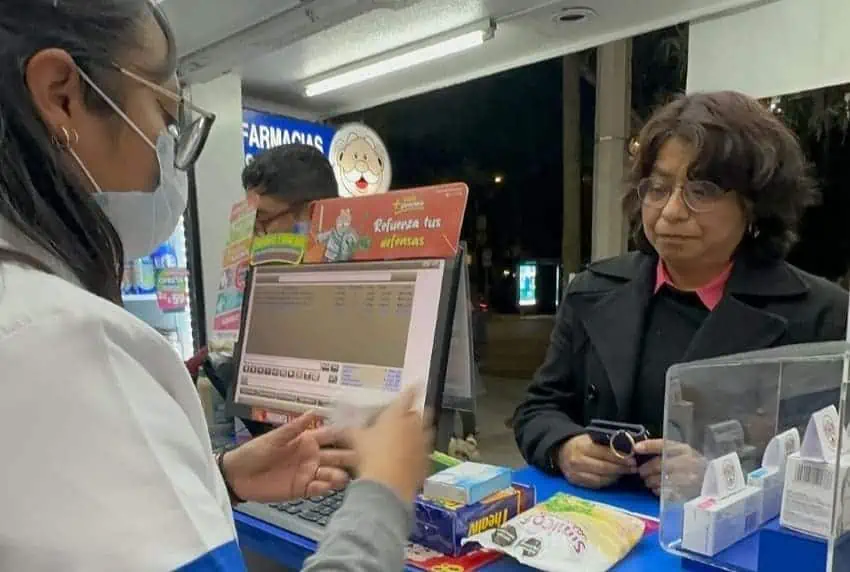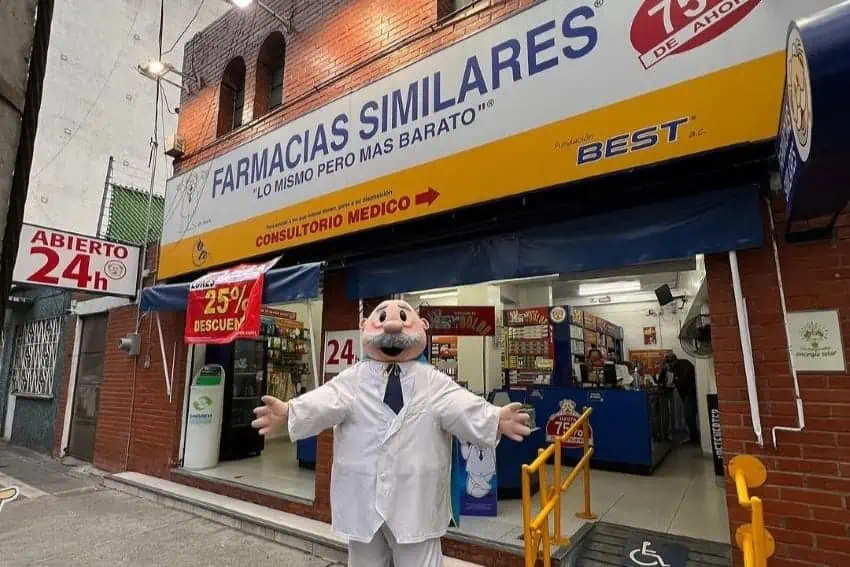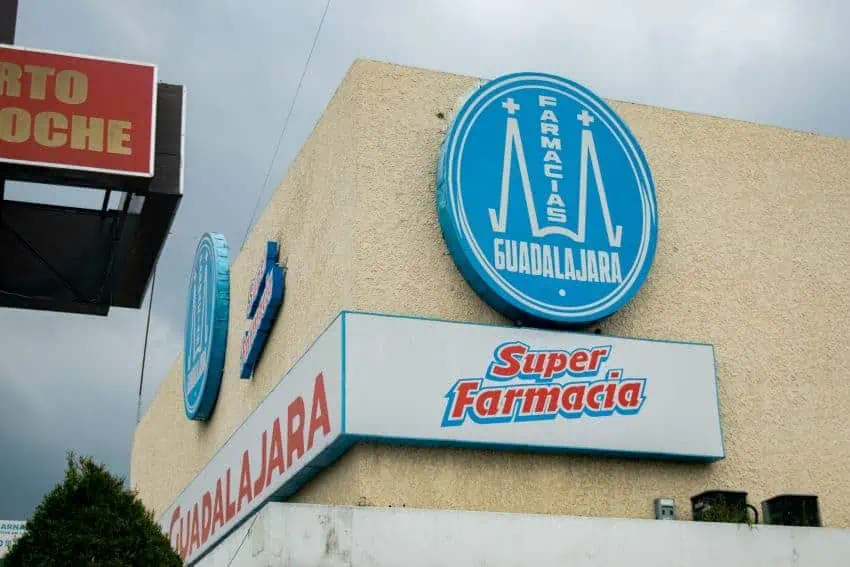The first time I walked into a Mexican pharmacy, I stood still in the doorway for a few beats.
Why was it so small? Where was everything? No candy aisle, no greeting card aisle, no sexual health or feminine hygiene products aisle. In fact, there was nothing that could even be called “an aisle.”.

For such a cramped space, it was incredibly confusing.
I soon learned the ropes, and now, my fine readers, it is time to pass that knowledge on to you. Here’s what to remember when it’s time to go to the pharmacy in Mexico:
- Not all pharmacies are created equally. In my neck of the woods, we can divide pharmacies up into three “tiers.” (When I say “tiers,” by the way, I’m not necessarily talking about quality, but about familiarity for those of us from the United States who are stores like Walgreens and CVS.)
At the bottom is Farmacias Similares, which is a regional low-cost pharmacy chain stocked with cheap, generic versions of many medicines. Many of these pharmacies also come with an attached consultorio (doctor’s office), where one can see a general doctor for minor illnesses like digestive or respiratory infections. The doctor will write you a prescription if one is warranted and recommend other medicines for your symptoms, which you can (of course) buy at the pharmacy. The fee for seeing the doctor is symbolic (about 50 pesos, or close to US $3), and the pharmacy itself is countertop-style and pretty no-frills — there’s no “store” to walk into. Needless to say, you must ask an attendant to fetch the medicines you need, and the supply of basic toiletries is fairly limited.
Farmacias Similares is one of the most important pharmaceutical chains in the country, covering the health of thousands of Mexicans at an affordable cost. (Dr. Simi/Instagram) Farmacias Similares, by the way, is where you might find someone dressed up in a Dr. Simi mascot costume, a staple of modern Mexican culture. As far as I’m concerned, their medicines are just as good as any others, though I have had doctors tell me not to buy certain medicines there, so apparently there are medical professionals out there who have their doubts, valid or not.
The next tier would include chains like Farmacias de Ahorro and Yza, which may or may not come with an attached consultorio (Farmacias de Ahorro usually does, and theirs is free). At these pharmacies, there is a little “store” area with items you can pick up and examine, though these are restricted to a fairly small variety of toiletries and over-the-counter medicines. Condoms are mercifully available in this area now as well (you had to ask for them at the counter when I first arrived in Mexico). On the shelves, you can also find things like nail clippers and lip balm, and maybe a few snacks and refrigerated drinks. A few different brands of baby formula and diapers are available behind the counter, as well. Most independent pharmacies are similarly stocked.
Finally — this is a long “item” for a list, I know — are larger pharmacies like Farmacias Guadalajara and Farmacias San Pablo, which are the most similar in terms of selection to a place like CVS, though without as much variety; I’d include grocery store pharmacy areas in this tier, as well. Medicines tend to be a little pricier, but if you need to get more specific toiletries or other things on the same trip that you might normally look for in a tiendita or grocery store, these pharmacies can be very convenient.
Lastly, homeopathic pharmacies are in their own class, and there’s usually a homeopathic doctor available if you choose to go that route.
At Farmacias Guadalajara you can find everything from medicines to food and toiletries. (Unsplash) - You don’t need a prescription for everything. When I first arrived, you could ask for pretty much any kind of medication, including antibiotics, and they would just sell it to you. That’s no longer true for antibiotics or stronger pain medications (more on that below).
One notable area on this subject is birth control: in Mexico, you can simply ask for birth control pills (by brand, as there are many), as well as the morning-after pill at a pharmacy without a prescription. While abortion before 12 weeks of gestation is now officially legal at the federal level in Mexico, asking for the abortion pill (Mifepristone) may yield success on a case-by-case basis, depending on the pharmacist you are dealing with. A quick online search of local pharmacies makes it appear that this is completely possible, but seek the advice of a medical professional.
Other medicines you might be surprised to learn you don’t need a prescription for are psychiatric, like many generic versions of SSRIs, a class of antidepressants used to treat depression and anxiety. Treatments that are known to be addictive, like stimulants, for example, are less widely available and can still only be bought with a prescription and are often subject to shortages. Weight-loss wonder drug Ozempic is similarly available over the counter across all of Mexico.
As with all major medical procedures and treatments, starting anything new under the treatment of a doctor is always the most advisable. - You probably won’t find everything you’re looking for. Part of this is simply because the market in Mexico is unique and certain brands haven’t expanded here (luckily Excedrin Migraine finally has…now if I could only get a hold of some Tylenol Sinus!). The lesson? If you have a go-to over-the-counter medicine that works for you, you might want to stock up during trips back home.
And if you’re looking for something particularly strong, such as opioids, you’re likely not going to find them anywhere outside of a hospital. If you do happen to find them, I’d advise you to be incredibly suspicious of their origin and authenticity: that level of pain medication in Mexico is typically reserved for palliative care; my mother couldn’t even access them after having surgery here. Since certain pharmacies in tourist and border areas have been found to sell counterfeit medications containing fentanyl (those that do typically advertise these drugs heavily to foreigners, another tell-tale sign worthy of avoidance and suspicion), it’s best to stay far away.
Like with many things in Mexico, a trip to the pharmacy will be a different experience than you’re probably used to, one in which you’ll need to interact with the people who work there to get what you need. Thankfully, you’ll likely find people to be as helpful and accommodating as they are elsewhere. Happy shopping, and get better soon!
Sarah DeVries is a writer and translator based in Xalapa, Veracruz. She can be reached through her website, sarahedevries.substack.com.


